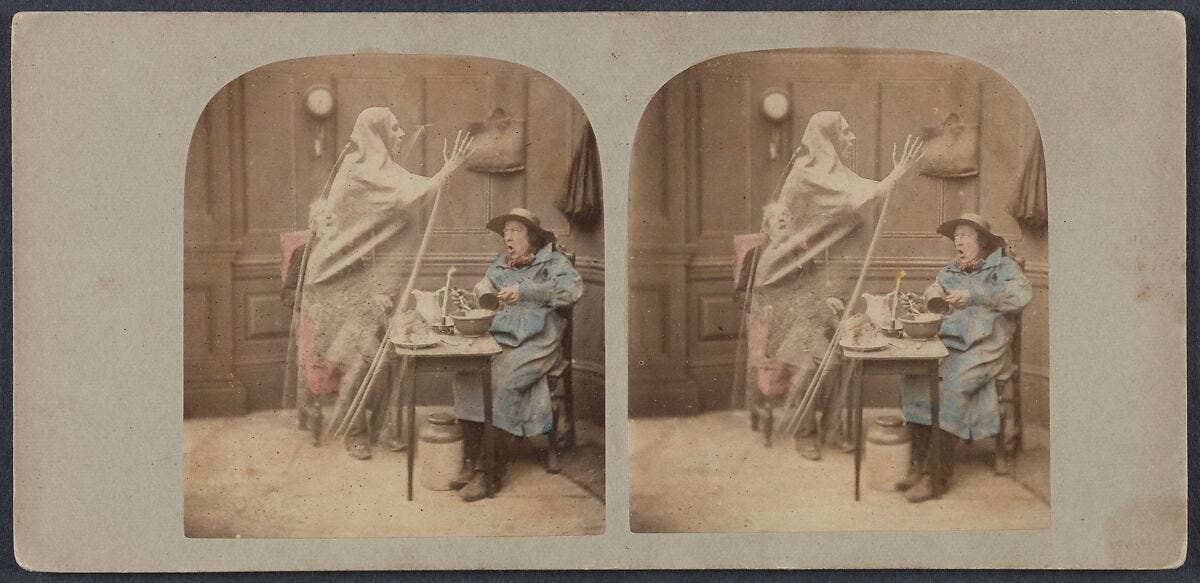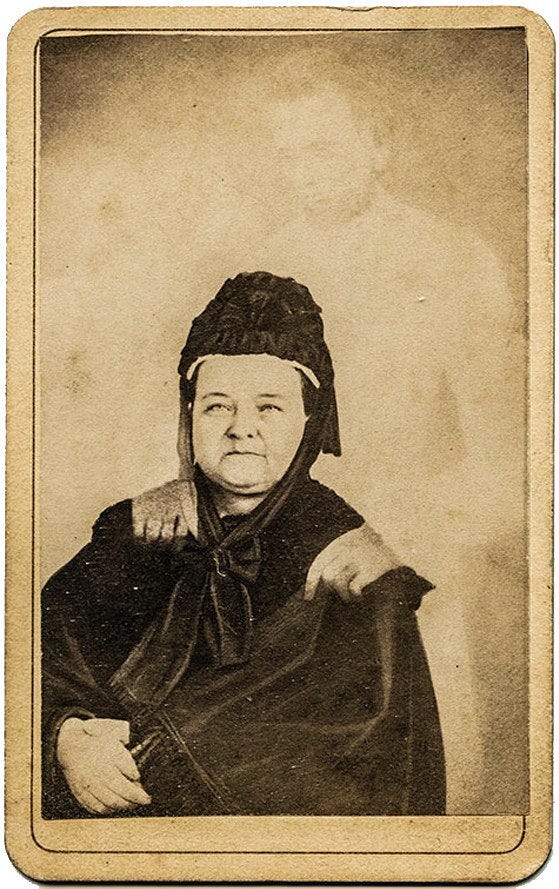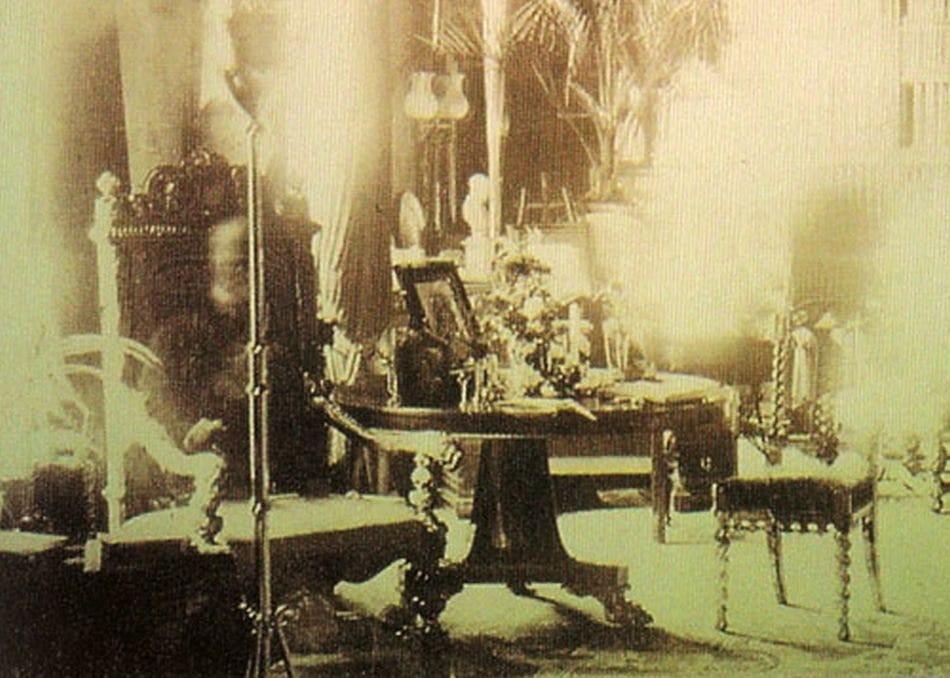How to Photograph a Ghost, According to the Victorians
As the camera became available to a wider share of the public, spirit photographers found spooky ways to embrace this new technology.

In 1862, a jewelry engraver in Boston took a photograph of a ghost.
Like many Americans, William Mumler had developed an interest in photography, and improvements in cameras had made this technology accessible to a larger portion of the public. Mumler decided to take a self-portrait. All proceeded smoothly, until he developed the photo. To his shock, the pale image of his long-deceased cousin hovered beside him.
At least, that’s how Mumler recounted the story to the media. The truth involves some creativity, technological sleight of hand, and a public hungry for spectral visions of dead relatives.
Patrons of the Gazette may remember an essay in the archive about the Cottingley fairies, in which two English girls stunned the world with photos of flower fairies taken at the bottom of their garden. The photos, snapped in 1920, were proven to be a hoax. From the mid-19th century until the 1920s, magical photos that claimed to prove the existence of ghosts (or fairies) captured the imagination of the public.
Mumler was the first person to commercialize the practice of spirit photography. He came to this realization by chance: while taking a self-portrait alone in his studio, he accidentally used a plate that had already been exposed, which resulted in the pale, superimposed image of a young woman in the background of the developed photo. He spun the story into a narrative about a deceased cousin and found himself at the center of a media storm.
However, Mumler was not the first to experiment with spirit photography. In 1856, the scientist Sir David Brewster realized that the long exposure times required of the era’s daguerreotypes meant that if someone briefly entered and exited the frame, they would appear translucent in the photo. The London Stereoscopic Company then adapted this technique to create their photographic series, “The Ghost in the Stereoscope.”
But this early proof that technology, not spirits, had created the illusion did not stop Mumler’s success. He began charging people $10 (or about $320 today) to be “photographed” with their deceased; with incredible enthusiasm from customers, he was soon able to quit his job as a jewelry engraver. His wife joined in, and she became a psychic medium.

What catapulted Mumler’s career internationally was the photograph he took of Mary Todd Lincoln, in which the faint image of Abraham Lincoln is visible in the background. Mrs. Lincoln was a devout Spiritualist, part of a growing movement of believers in the United States and Britain. Spiritualists believed in psychic abilities and mediumship as tools to communicate with the dead. Like spirit photography, their occult beliefs were paired with the new language of scientific experimentation and technology, as Spiritualists argued that they could prove the validity of mediumship as one would prove a scientific theory.
Mumler’s career met a stumbling block in 1869, when P. T. Barnum of all people grew hell-bent on exposing Mumler as a fraud. Phineas Taylor Barnum, best known for co-founding the Ringling Bros. and Barnum & Bailey Circus, was himself known for promoting hoaxes like the Fiji mermaid. But after some photography practice of his own, Barnum discovered the double-exposure technique that allowed Mumler to create fake photos of ghosts. Mumler was brought to trial in 1869 after some of his photos included “ghosts” who were very much still alive. Barnum testified against him, and to prove the simplicity of this scam, he created his own photos of himself with Abraham Lincoln.
Hilariously, Mumler was acquitted on the grounds that the jury couldn’t prove beyond a reasonable doubt that he had faked the photos. He spent his final years largely in the realm of the living, and he succeeded in developing photo-electrotype plates that could be easily produced and printed.
Despite Mumler’s fall, other spirit photographers followed his example across the pond. In Britain, Frederick Hudson and William Hope dazzled believers with their images of ghosts. Édouard Isidore Buguet, a prominent French spirit photographer working in London, was arrested in 1875 and confessed to fraud. Hudson and Hope used similar deceitful methods through pre-exposed plates, creating the illusion of spirits floating around their main subjects.

One famous spirit photograph happened by accident: an image of a ghost sitting in the library of Combermere Abbey, photographed by Sybell Corbet in 1891. The late Lord Combermere was being buried while his sister-in-law Sybell took the photo, leading some to believe that it was indeed the ghost of the deceased viscount. After all, the ghost was seated in what had been his favorite chair. Because the exposure time would have taken over an hour, critics pointed out that someone in the household (perhaps a servant?) could have entered that room at any point and left. But the servants at Combermere Abbey insisted that they had all gone to the funeral, which was several miles away. Why Sybell Corbet decided to take that photo during her brother-in-law’s funeral is unclear.
Spirit photography found both powerful critics, like Harry Houdini, and powerful supporters—among them, the ardent Spiritualist Sir Arthur Conan Doyle, who wrote in support of spirit photography as well as the Cottingley fairies.
Why were Victorians and Edwardians so eager to believe? As we’ve explored in past essays on the Spiritualist Movement, rapid technological development often inspires spiritual backlash, as we grow wary of becoming disconnected from faith and nature. The height of Spiritualism as a movement was also bookended by two major wars: the American Civil War and World War I. With thousands of grieving family members seeking answers, spirit photographers found a steady stream of clients. Mary Todd Lincoln had lost a son and a husband during the Civil War. Arthur Conan Doyle lost a son and a brother during WWI.
Interest in spirit photography declined after the 1920s, thanks to the efforts of debunkers like Houdini, who loathed to see vulnerable people tricked by swindlers. In an age when artificial intelligence can now be used to manipulate images, I find it fascinating to pull back the veil on another era when unfamiliar technology was employed to play similar tricks.
It’s all ludicrous, because no respectable ghost would be caught dead in a machine. They’d be the odd shadow in the graveyard, the chill on a windswept moor, the creak of a stair in an ancient house—just behind your shoulder, in the corner of your eye.
Recently on Fireside Fables: Folklore from the Salem Witch Trials!
Last week’s episode of Fireside Fables covered the legacy of folklore that emerged from Colonial America’s infamous witch trials. If you’re a patron of the Gazette, you also have access to a full series on the history of the trials in the archive.
Watch the episode below (12 minutes):



Loooved this! I just went to a magic lantern (the projector) show the other night and learned about how it was also used to project ghosts and spirits for audiences. Fascinating!
Really good story! Well told. Ghosts are everywhere in photography during those years. Great fun! Thank you for an excellent read!